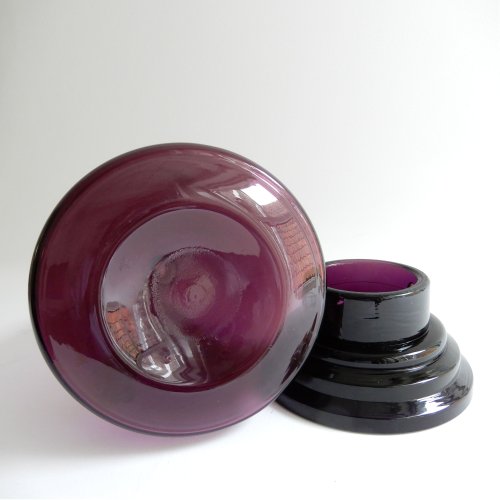Chris Lebeau (1878-1945), Uitvoering Glasfabriek Leerdam Purple flower vase on pressed-glass base.
About this piece
Beautiful and Stylish Vase
This stunning, stylish vase is already a masterpiece in its elegant simplicity but becomes even more remarkable with its stepped pressed-glass base in the same warm, deep purple color.
Chris Lebeau was a great and versatile artist, as demonstrated by this monumental vase designed in 1924/25 for the Leerdam Glass Factory. During that time, Lebeau created a series of flower vases, typically placed on dark purple pressed-glass pedestals. The beautifully shaped vases were inspired by various plant species as well as the flowers they were intended to hold. Chris Lebeau consistently refused to design anything that could be used to serve alcohol, as he was a committed teetotaler.
The underside of the vase is signed with Chris Lebeau’s etched monogram.
Biography
Joris Johannes Christiaan (Chris) Lebeau (May 26, 1878, Amsterdam – April 2, 1945, Dachau) was an exceptionally versatile and prolific artist, resistance fighter, and anarchist.
Chris Lebeau grew up in a large, impoverished family as the son of a staunch socialist. From 1892 to 1899, he attended the Quellinus Drawing School and the National School of Applied Arts. He later studied drawing in the evening program at the Rijksakademie van Beeldende Kunsten in Amsterdam from 1901 to 1903. Additionally, he took drawing lessons at the Vâhana school under De Bazel and Lauweriks, whose influence profoundly shaped his approach to art. As an artist, Lebeau remained devoted to Jugendstil or Art Nouveau, initially in applied arts and later across a wide variety of artistic disciplines. His curiosity drove him to master new techniques, such as glass art. His remarkable oil portraits from the 1930s, however, are purely realistic in style.
Lebeau was a true polymath. He introduced Europe to the previously unknown technique of batik by showcasing his batik work at the Paris Exposition in 1900.
In addition, he designed wallpaper patterns, worked with linen, created graphic works such as lithographs and etchings, produced calendars, designed posters and ex-libris, and painted landscapes, still lifes, and portraits.
He also designed and crafted glass. This vase was created for Leerdam, where Lebeau collaborated extensively with the much younger Copier. Together, they began making "Unica" pieces. However, after a disagreement, Lebeau moved to Bohemia, where he worked with Moser to create "Unica" pieces for a few months at a time. These unique works were exceptional. After a while, he moved on to other pursuits, but his contribution to glass art remains significant, and he is regarded as one of the greats of his era.
In addition to glassblowing and design, he also worked with stained glass, created sculptures, and explored numerous other art forms. His versatility and productivity were remarkable.
When the Nazis came to power, Lebeau entered a sham marriage with a German Jewish woman in 1935. He married multiple times, often in open arrangements. An anarchist, vegetarian, and teetotaler, Lebeau joined the resistance with his wife and a former student and fellow artist, Sixta Heddema. Together, they forged documents and provided aid to Jewish Dutch citizens. On November 3, 1943, Chris Lebeau, his wife, and Heddema were arrested. Lebeau took full responsibility, ensuring that his wife and Heddema were released. He refused to abandon his resistance activities.
After being transferred to Kamp Vught, Lebeau arrived at Dachau in May 1944. He ultimately died of exhaustion on April 2, 1945.
Literature:
- A. v.d. Kley-Blekxtoon; "Leerdam Glas 1878-2003", 4th edition, page 80, illustration 86.
- Collection Meentwijck – 'Leven in een collectie' Toegepaste kunst 1890-1940 ("Living in a Collection: Applied Arts 1890-1940,") Museum Singer / Publisher Waanders, Zwolle, 2000, pp. 203-213.
- "Wat is Art Nouveau & Art Deco Waard," Volumes I & II, uitgegeven door Rob Zeegers, Janny Stuurman-Aalbers, en Reinold Stuurman, Uitgeverij Scriptum Art, Schiedam, NL, en Snoeck-Ducaju & Zoon, Gent, België, 2001. Volume II, pp. 42-43, illustration p. 42.
Condition
The vase is in excellent condition, with some minor production imperfections such as a small air bubble in the vase and slight mould seams on the base.
Material:
Glass
Measurements:
flesvaas
Height: 35 cm
(13,78")
Neck diameter: 3 cm
(1,18")
Foot diameter: 14,9 cm
(5,87")
voet
Height: 7 cm
(2,76")
Totale hoogte is :
Height: 41 cm
(16,14")
Period:
1924/25
Origin:
the Netherlands
Artist / atelier:
Chris Lebeau, Uitvoering Glasfabriek Leerdam









